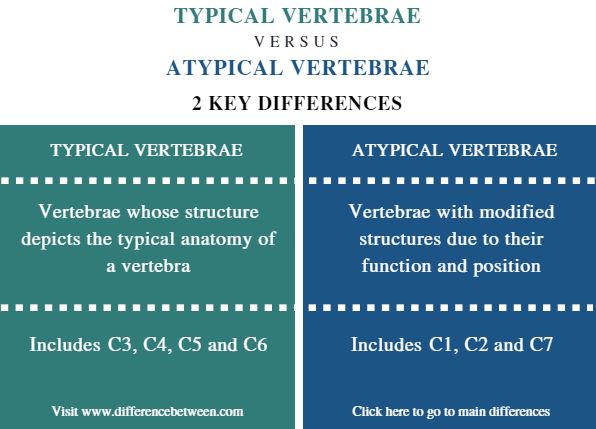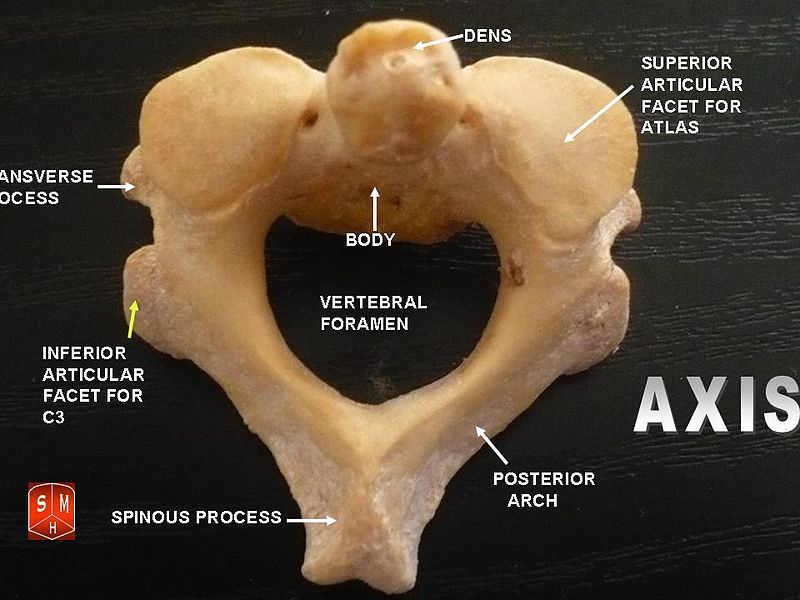The key difference between typical and atypical vertebrae is that typical vertebrae consist of all basic components of a vertebra while atypical vertebrae are the vertebrae that have modified structure due to their position and function.
The vertebral column is the segmented series of bones that protect the spinal cord and bears the weight of the spine and the body above it. It is a typical characteristic of vertebrates. An adult has 26 vertebrae in the vertebral column. The basic structure of a vertebra differs according to the position and function. Hence, based on the basic structure of the vertebrae, they can be grouped as typical and atypical vertebrae.

CONTENTS
1. Overview and Key Difference
2. What are Typical Vertebrae
3. What are Atypical Vertebrae
4. Similarities Between Typical and Atypical Vertebrae
5. Side by Side Comparison – Typical vs Atypical Vertebrae in Tabular Form
6. Summary
What are Typical Vertebrae?
Typical vertebrae are vertebrae whose structure consists of all basic components. They depict the basic anatomy of a vertebra. Also, they contain two major parts: vertebral body and vertebral arch. Furthermore, the vertebral arch contains pedicles, laminae, and seven processes. These seven processes include spinous process, two transverse processes, two superior articular processes and two inferior articular processes. Moreover, most vertebrae in an adults’ vertebral column are typical while few are atypical.

Figure 01: Typical Vertebra
Out of the seven cervical vertebrae, C2, C3, C4, C5, and C6 are typical vertebrae which posses basic anatomic structure of a vertebra. Most of the thoracic vertebrae are typical (T2 – T8) too. In addition to these, the four lumbar vertebrae are also typical (L1- L4).
What are Atypical Vertebrae?
Atypical vertebrae are the vertebrae with modified structures due to their function and position. Out of the seven cervical vertebrae, C1 (atlas), C2 (axis) and C7 (vertebra prominens) are atypical vertebrae. Moreover, C1 vertebra lacks spinous process. Axis vertebra contains a vertical projection called dens. C7 vertebra has a non-bifid longer spinous process. T1, T9, T10, T11, and T12 are also atypical.

Figure 02: Atypical vertebra – Axis vertebra
Among lumbar vertebrae, L5 is an atypical vertebra since it has a small spinous process and the largest and bulkiest transverse processes.
What are the Similarities Between Typical and Atypical Vertebrae?
- The location of both vertebrae is the vertebral column.
- The two groups of vertebrae include cervical, thoracic and lumbar vertebrae.
What is the Difference Between Typical and Atypical Vertebrae?
Typical vs Atypical Vertebrae | |
| Typical Vertebrae are the vertebrae whose structure depicts the typical anatomy of a vertebra. | Atypical Vertebrae are the vertebrae with modified structures due to their function and position. |
| Cervical Vertebrae | |
| C3, C4, C5 and C6 | C1, C2 and C7 |
| Thoracic vertebrae | |
| T2, T3, T4, T5, T6, T7, and T8 | T1, T9, T10, T11, and T12 |
| Lumbar Vertebrae | |
| L1, L2, L3, and L4 | L5 |
Summary – Typical vs Atypical Vertebrae
In brief, vertebrae are individual cylindrical bones which make up the vertebral column of vertebrates. Typical vertebrae exhibit a basic anatomical structure composed of all components. Atypical vertebrae are the vertebrae whose structure is a little bit different from that of the basic anatomy due to vertebra function and position. Thus, this is the difference between typical and atypical vertebrae.
Reference:
1. “Integrated Publishing, Inc.” Medical Reference and Training Manuals, Available here.
2. Luijkx, Tim. “Typical Cervical Vertebrae | Radiology Reference Article.” Radiopaedia.org, Available here.
Image Courtesy:
1. “Vertebra Superior View-en” By Jmarchn – Own work (CC BY-SA 3.0) via Commons Wikimedia
2. “Axis vertebrae” By Anatomist90 – Own work (CC BY-SA 3.0) via Commons Wikimedia
ncG1vNJzZmivp6x7pbXFn5yrnZ6YsqOx07CcnqZemLyue8OinZ%2Bdopq7pLGMm5ytr5Wau27A2KmgnJmcYq6vsIyaq7KomZiurXnVnqmtnZKnrqZ7